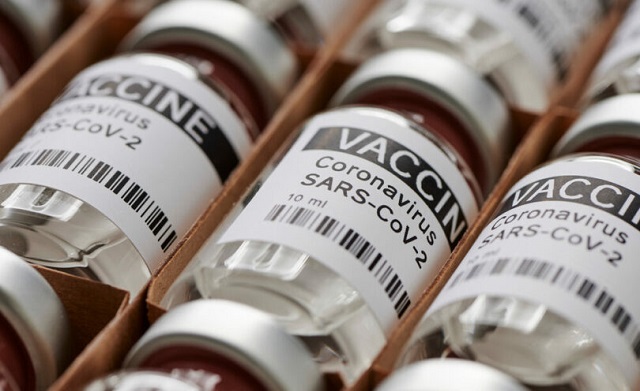COVID-19
Emails obtained by CHD reveal government’s failure to monitor COVID vaccine injury reports

This article was originally published by The Defender — Children’s Health Defense’s News & Views Website.
By and
VAERS received approximately 1.4 million reports of adverse events associated with the COVID shots, including 91,000 for Janssen, 491,000 for Moderna and 806,000 for Pfizer… despite these numbers, the FDA noted a steadily increasing number of alerts for adverse events associated with the Janssen vaccines, while noting just a handful of alerts for Moderna and Pfizer
Newly posted email records on the U.S. Food and Drug Administration (FDA) website reveal that in the first 18 months after COVID-19 vaccines were rolled out to the public, the agency’s data monitoring of the Vaccine Adverse Event Reporting System (VAERS) showed consistent alerts for serious adverse events (including death) for the Janssen vaccine.
Meanwhile, the FDA’s monitoring found almost no safety signals for the Moderna and Pfizer shots, failing to detect signals even for widely recognized risks like myocarditis, pericarditis, and anaphylaxis.
The information is contained in emails sent by the FDA to key personnel in the Centers for Disease Control and Prevention’s (CDC) Immunization Safety Office between Jan. 12, 2021 and July 5, 2022.
Each email is accompanied by a list of adverse events for which the FDA says its weekly data analysis of VAERS yielded a statistical “alert” indicating a potential safety issue with the COVID-19 shots that may have required action on the agencies’ part.
The FDA posted the emails — under the banner “Empirical Bayesian Data Mining Records” — one day after the agency objected to a motion filed by Children’s Health Defense (CHD) in federal court pertaining to a 2023 Freedom of Information Act (FOIA) lawsuit.
The motion asks the court to order the FDA to disclose VAERS safety-monitoring records that CHD requested from the agency in July 2022.
According to Ray Flores, senior outside counsel to CHD, “The emails are further evidence of the federal government’s failure to make good on its promises to use VAERS as an ‘early warning system’ to detect and act on risks associated with the new vaccines.”
CDC claimed vaccines were ‘safe’ despite record number of VAERS reports
The CDC’s searchable online VAERS database indicates that in the 18 months of data monitoring covered by the emails, VAERS received approximately 1.4 million reports of adverse events associated with the COVID shots, including 91,000 for Janssen, 491,000 for Moderna and 806,000 for Pfizer.
The emails show that despite these numbers, the FDA noted a steadily increasing number of alerts for adverse events associated with the Janssen vaccines, while noting just a handful of alerts for Moderna and Pfizer, mostly for product administration issues.
Due to concerns about six instances of severe blood clotting, the CDC and FDA “paused” the Janssen vaccine’s authorization on April 13, 2021. However, the agencies lifted the pause 10 days later, based on a “review of all available data and in consultation with medical experts and based on recommendations from the CDC’s Advisory Committee on Immunization Practices [ACIP].”
The agencies wrote that they had “confidence that this vaccine is safe,” and promised they would “continue with these efforts to closely monitor the safety of these vaccines.”
However, after the pause was lifted, the FDA emails show that the agency consistently noted EB-mining alerts for Janssen vaccines for various types of thrombotic and other serious adverse events, including death.
For example, an alert for “deep vein thrombosis” was noted on May 11, 2021, and in every subsequent email. An alert for “death” was noted on March 8, 2022, and in every subsequent email.
READ: Cancer drug pioneer praises RFK Jr., suggests link between childhood cancer and COVID shots
In December 2021, the ACIP recommended “preferential use of mRNA COVID-19 vaccines over the Janssen COVID-19 vaccine.” However, Janssen remained available in the U.S. until May 22, 2023, when the company requested a withdrawal of the emergency use authorization (EUA).
For the Pfizer and Moderna shots, the FDA emails show that in 18 months of EB mining, the FDA noted alerts for various types of product administration issues and a handful of clinical outcomes, but failed to note alerts for myocarditis, pericarditis and anaphylaxis.
Yet as of June 30, 2022, VAERS had received 8,333 anaphylaxis reports (including 1,656 for Moderna, 6,427 for Pfizer, and 227 for Janssen), 10,166 pericarditis reports (including 1,879 for Moderna, 8,084 for Pfizer, and 181 for Janssen), and 15,353 myocarditis reports (including 3,607 for Moderna,11,487 for Pfizer, and 215 for Janssen), according to the CDC’s database.
CDC anticipated deluge of vaccine injury reports following COVID shots
According to the CDC, COVID-19 shots “underwent the most intensive safety analysis in U.S. history” and “continue to be monitored for safety.” A key component of that monitoring is VAERS, which the agency refers to as the “nation’s early warning system that monitors the safety” of vaccines, and “can often quickly detect an early hint or warning of a safety problem with a vaccine.”
VAERS, which is co-managed by the Centers for Disease Control (CDC) and Prevention and the FDA, is a “passive” monitoring system that accepts reports of adverse events experienced after vaccination.
Months before the FDA granted emergency use authorizations for the COVID-19 shots, the CDC anticipated that VAERS would be deluged with reports of adverse events following COVID-19 vaccination.
READ: Canadian parents wary of COVID, flu shots for children despite government propaganda: report
In a July 2020 multimillion-dollar VAERS-management contract between the CDC and General Dynamics Information Technologies (GDIT), the CDC predicted that the “total number of reports received during periods of peak activity (which are not expected to reflect sustained activity) is expected to be 1,000 reports per day, with up to 40% of the reports serious.”
As it turned out, the GDIT contract underestimated the number of adverse events. According to monthly status reports from GDIT, in January 2021, the number of incoming reports rose to over 2,500 per day.
By April 2021, GDIT indicated it would begin processing 25,000 reports per week to keep up with new and backlogged reports.
FDA, CDC promised to use 2 types of data analysis to detect safety signals in VAERS
Despite the unprecedented volume of adverse event reports for COVID-19 shots, the CDC and FDA have consistently noted that a report to VAERS does not, on its own, prove that a vaccine caused the reported adverse event — nor does a high number of adverse events reported for a particular type of vaccine prove causation.
Rather, to determine whether there could be a causal link between a vaccine and a particular type of adverse event, the CDC and FDA monitor VAERS in various ways, including by using data mining to look for statistical “signals” indicating a higher-than-expected number of reports for a given type of adverse event.
When the data analysis yields a signal, further investigation is required to determine if the vaccine poses a safety risk.
The agencies’ VAERS safety-monitoring duties for the COVID-19 shots are spelled out in the VAERS “Standard Operating Procedures (SOP) for COVID-19 (as of 29 January 2021),” which states that the agencies would conduct “routine VAERS surveillance to identify potential new safety concerns for COVID-19 vaccines.”
The VAERS SOP describes how the agencies would detect potential safety signals, stating:
“Two main approaches to data mining are Proportional Reporting Ratios (PRRs) and Empirical Bayesian Geometric Means. Both have published literature suggesting criteria for detecting “signals.” PRR will be used at CDC for potential signal detection; Empirical Bayesian data mining will be performed by FDA.”
The SOP specifies that PRR analysis would be conducted on a weekly basis or “as needed” and EB mining would be conducted at least bi-weekly.
Under the VAERS SOP, the agencies would “share and discuss results of data mining analyses and signals” and investigate potential signals as necessary to determine whether they indicated genuine safety concerns.
The process is also described in a March 2023 letter from the FDA and CDC to Florida Surgeon General Joseph Ladapo:
“FDA and CDC physicians continuously screen and analyze VAERS data for possible safety concerns related to the COVID-19 vaccines. For signals identified in VAERS, physicians from FDA and CDC screen individual reports, inclusive of comprehensive medical record review.”
The VAERS SOP also promised that the VAERS contractor (GDIT) would provide daily emails to the CDC and the FDA with lists of VAERS ID numbers for “adverse events of special interest” (AESIs), and that FDA would routinely conduct “manual review” of AESIs.
Agencies relied solely on FDA analysis, even after confirming failure to detect key signals
According to Brian J. Hooker, Ph.D., CHD’s chief scientific officer:
“PRR and EB mining provide complementary methods of ‘disproportionality analysis.’ Essentially, PRR compares the rate of adverse events in the vaccine being studied with the rate in another vaccine (typically of older vintage), looking for statistical signals that the rate in the studied vaccine exceeds expectations.
“EB mining also looks for statistical signs of a disproportionately high number of adverse events. However, the basis for comparison is the expected rate of the event in question, typically in the general population.”
Potential safety signals that are eventually highlighted by both approaches may be highlighted earlier by PRR, according to the Council for International Associations of Medical Societies.
In June 2022, responding to a FOIA request from CHD, the CDC admitted it did not conduct the PRR analysis described in the VAERS SOP.
In 2023, responding to additional FOIA requests from CHD and the Epoch Times — and a lawsuit brought by CHD — the CDC said the agencies relied solely on the FDA’s EB mining to analyze “disproportionate reporting” because PRR is “prone to false signals” and EB mining is “a more robust data mining technique.”
Despite the CDC’s decision not to conduct the weekly analysis described in the VAERS SOP, the agency did conduct some PRR analysis for a brief period, from March 25, 2022 through July 31, 2022.
The CDC told CHD it did this for the purpose of “corroborating” the FDA’s EB mining results.
According to PRR records that the CDC eventually provided to CHD as part of the FOIA lawsuit, for the first six weeks of the PRR analysis, the CDC simply compared the adverse event rates between Moderna and Pfizer shots. However, on May 6, the CDC started comparing Pfizer and Moderna mRNA shots to non-COVID vaccines.
According to the CDC, the results of the PRR analysis were “generally consistent with empirical Bayesian data mining, revealing no additional unexpected safety signals.” However, unlike the few alerts detected through the EB mining, the PRR analyses comparing mRNA shots to non-COVID vaccines revealed hundreds of potential safety signals.
For example, the May 6, 2022 analysis, covering reports received by VAERS on or before that date, flagged 777 symptoms, of which 171 are serious, including death, cardiac arrest, and stroke.
For 5-to-11 year-olds, the analysis flagged 56 symptoms, of which 20 are serious, including myo- and pericarditis. For 12-to-17 year-olds, the analysis flagged 95 symptoms, of which 45 are serious, also including myo- and pericarditis.
In stark contrast to these PRR flags, the EB mining runs for Pfizer and Moderna shots on May 10 yielded alerts for nine events related to vaccine administration and a mere three clinical outcomes (‘mechanical urticaria’, ‘exposure via breast milk’, and ‘drug ineffective’).
Despite the apparent failure of the FDA’s EB mining to detect signals that the CDC detected through PRR, the CDC told CHD in June 2023 that the agencies would continue to rely solely on the EB mining, “[g]iven that it is a ‘gold standard’ mining technique.”
“The results of these two methods are simply not ‘generally consistent,’ and a pharmacovigilance system that detects a mere three clinical outcomes while failing to detect the most serious adverse events certainly does not qualify as a ‘gold standard.’” Hooker said. “The CDC’s conclusion that the PRR results support the agencies’ exclusive reliance on EB mining cannot possibly have been made in good faith.”
Agencies have yet to disclose key records of activities under VAERS SOP
Through FOIA requests submitted to the FDA and CDC in the summer of 2022, and the lawsuits filed against both agencies in early 2023, CHD has been attempting to obtain records of the agencies’ activities and findings under the VAERS SOP during the first 18 months after the COVID shots became publicly available in the U.S.
CHD also seeks records of the FDA’s manual review of AESIs; communications and consults between the agencies regarding data mining results and signals; follow-up investigation done in connection with any signals detected; and the daily email reports of adverse events sent to CDC and FDA by the VAERS contractor.
Although the CDC provided some records after CHD sued the agency and the FDA recently posted the emails containing EB-mining results where an alert was generated, many key records are still outstanding.
In connection with the EB mining, the FDA has yet to provide the records of data-mining runs that did not result in alerts, and full data for any of the runs, which should include variables such as the expected rates of adverse events that formed the basis for the FDA’s comparisons.
Additionally, the agencies have not provided records of discussions or consults regarding signals, or records of follow-up investigations they may have conducted when a signal was detected.
The delay in producing records is due in part to court-ordered stays of both lawsuits. The stays were granted after the FDA told courts it does not have ability to process CHD’s FOIA requests because its resources are devoted to fulfilling orders from a Texas court requiring the agency to produce licensing documents for the COVID-shots.
Despite recent calls for “transparency” by a top FDA vaccine official, Dr. Peter Marks, the FDA says it has requested similar stays in at least 10 other FOIA lawsuits, and has received stays in seven of those, including a second CHD lawsuit, which seeks records of the FDA’s safety monitoring of COVID-19 vaccines through its “active surveillance” system.
This article was originally published by The Defender
COVID-19
Judge denies Canadian gov’t request to take away Freedom Convoy leader’s truck

From LifeSiteNews
A judge ruled that the Ontario Court of Justice is already ‘satisfied’ with Chris Barber’s sentence and taking away his very livelihood would be ‘disproportionate.’
A Canadian judge has dismissed a demand from Canadian government lawyers to seize Freedom Convoy leader Chris Barber’s “Big Red” semi-truck.
On Friday, Ontario Court of Justice Judge Heather Perkins-McVey denied the Crown’s application seeking to forfeit Barber’s truck.
She ruled that the court is already “satisfied” with Barber’s sentence and taking away his very livelihood would be “disproportionate.”
“This truck is my livelihood,” said Barber in a press release sent to LifeSiteNews.
“Trying to permanently seize it for peacefully protesting was wrong, and I’m relieved the court refused to allow that to happen,” he added.
Criminal defense lawyer Marwa Racha Younes was welcoming of the ruling as well, stating, “We find it was the right decision in the circumstances and are happy with the outcome.”
John Carpay, president of the Justice Centre for Constitutional Freedoms (JCCF), said the decision is “good news for all Canadians who cherish their Charter freedom to assemble peacefully.”
READ: Freedom Convoy protester appeals after judge dismissed challenge to frozen bank accounts
“Asset forfeiture is an extraordinary power, and it must not be used to punish Canadians for participating in peaceful protest,” he added in the press release.
As reported recently by LifeSiteNews, the Canadian government claimed that Barber’s truck is an “offence-related property” relating to his involvement in the 2022 protests against Canada’s COVID mandates.
At this time, the court ruling ends any forfeiture proceedings for the time being, however Barber will continue to try and appeal his criminal conviction and house arrest sentence.
Barber’s truck, a 2004 Kenworth long-haul he uses for business, was a focal point in the 2022 protests. He drove it to Ottawa, where it was parked for an extended period of time, but he complied when officials asked him to move it.
On October 7, 2025, after a long trial, Ontario Court Justice Perkins-McVey sentenced Barber and Tamara Lich, the other Freedom Convoy leader, to 18 months’ house arrest. They had been declared guilty of mischief for their roles as leaders of the 2022 protest against COVID mandates, and as social media influencers.
Lich and Barber have filed appeals of their own against their house arrest sentences, arguing that the trial judge did not correctly apply the law on their mischief charges.
Government lawyers for the Crown have filed an appeal of the acquittals of Lich and Barber on intimidation charges.
The pair’s convictions came after a nearly two-year trial despite the nonviolent nature of the popular movement.
COVID-19
Freedom Convoy protester appeals after judge dismissed challenge to frozen bank accounts

From LifeSiteNews
Protestor Evan Blackman’s legal team argues Trudeau’s Emergencies Act-based bank account freezes were punitive state action tied directly to protest participation.
A Freedom Convoy protester whose bank accounts were frozen by the Canadian government says a judge erred after his ruling did not consider the fact that the funds were frozen under the Emergencies Act, as grounds for a stay of proceedings.
In a press release sent out earlier this week, the Justice Centre for Constitutional Freedoms (JCCF) said that Freedom Convoy protestor Evan Blackman will challenge a court ruling in his criminal case via an appeal with the Ontario Superior Court of Justice.
“This case raises serious questions about how peaceful protest is treated in Canada and about the lasting consequences of the federal government’s unlawful use of the Emergencies Act,” noted constitutional lawyer Chris Fleury. “The freezing of protestors’ bank accounts was part of a coordinated effort to suppress dissent, and courts ought to be willing to scrutinize that conduct.”
Blackman was arrested on February 18, 2022, during the police crackdown on Freedom Convoy protests against COVID restrictions, which was authorized by the Emergencies Act (EA). The EA was put in place by former Prime Minister Justin Trudeau’s Liberal government, which claimed the protests were violent, despite no evidence that this was the case.
Blackman’s three bank accounts with TD Bank were frozen due to his participation in the Freedom Convoy, following a directive ordered by Trudeau.
As reported by LifeSiteNews, in November of this year, Blackman was convicted at his retrial even though he had been acquitted at his original trial. In 2023, Blackman’s “mischief” and “obstructing police” charges were dismissed by a judge due to lack of evidence and the “poor memory of a cop regarding key details of the alleged criminal offences.”
His retrial resulted in Blackman getting a conditional discharge along with 12 months’ probation and 122 hours of community service, along with a $200 victim fine surcharge.
After this, Blackman’s application for a stay of proceedings was dismissed by the court. He had hoped to have his stay of proceedings, under section 24(1) of the Charter of Rights and Freedoms, allowed. However, the judge ruled that the freezing of his bank accounts was legally not related to his arrest, and because of this, the stay of proceedings lacked standing.
The JCCF disagreed with this ruling, noting, it “stands in contrast to a Federal Court decision finding that the government’s invocation of the Emergencies Act was unreasonable and violated Canadians’ Charter rights, including those targeted by the financial measures used against Freedom Convoy protestors.”
As of press time, a hearing date has not been scheduled.
In 2024, Federal Court Justice Richard Mosley ruled that Trudeau was “not justified” in invoking the Emergencies Act.
In early 2022, the Freedom Convoy saw thousands of Canadians from coast to coast come to Ottawa to demand an end to COVID mandates in all forms. Despite the peaceful nature of the protest, Trudeau’s federal government enacted the EA in mid-February.
After the protesters were cleared out, which was achieved through the freezing of bank accounts of those involved without a court order as well as the physical removal and arrest of demonstrators, Trudeau revoked the EA on February 23, 2022.
-

 International14 hours ago
International14 hours agoGeorgia county admits illegally certifying 315k ballots in 2020 presidential election
-

 Business2 days ago
Business2 days agoICYMI: Largest fraud in US history? Independent Journalist visits numerous daycare centres with no children, revealing massive scam
-

 Alberta1 day ago
Alberta1 day agoAlberta project would be “the biggest carbon capture and storage project in the world”
-

 Energy1 day ago
Energy1 day agoCanada’s debate on energy levelled up in 2025
-

 Haultain Research16 hours ago
Haultain Research16 hours agoSweden Fixed What Canada Won’t Even Name
-

 Business15 hours ago
Business15 hours agoWhat Do Loyalty Rewards Programs Cost Us?
-

 Business1 day ago
Business1 day agoSocialism vs. Capitalism
-

 Energy1 day ago
Energy1 day agoNew Poll Shows Ontarians See Oil & Gas as Key to Jobs, Economy, and Trade




